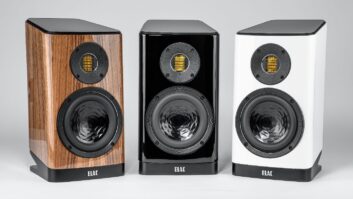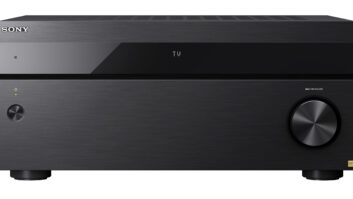They are playing more than the Yellow Rose of Texas in San Antonio these days. What some call the future of home audio is being demonstrated every Saturday at Bjorn’s Audio-Video Home Theater, and the consensus is that it’s a hit. Tom Holman, creator of THX and 5.1 multi-channel sound and Bjorn Dybdahl, president of Bjorn’s, have teamed up to preview this next generation of audio wizardry called 10.2 multi-channel surround sound. Holman created 5.1 multi-channel sound in 1987. The first Batman and Jurassic Park films introduced it to movie theater audiences in the early ’90s. It has since become the standard for movie theater surround sound, with 6.1 and 7.1-enabled theaters also representing a small percentage of screens. Thanks to DVD-A and SACD, 5.1 is now proliferating in the home theater market as well, so many people, including Holman and Dybdahl, believe it is time for the next great leap forward.
“We’re seeing an upwards pressure on the number of channels caused by the need to do something more, different or superior,” said Holman, who is president of TMH Labs and a professor at USC. “We’re out there pushing the limits of the envelope. Nobody else is doing this because they are not rethinking things… it takes a lot of work.”
His latest audio breakthrough, 10.2 multi-channel surround sound, can only be heard today, in a few select venues, including Bjorn’s Audio-Video. Dybdahl is a prominent industry dealer and one of the founding members of CEDIA. He recently rebuilt his 15,000-foot retail store from the ground up, adding three rooms for lifestyle systems, a “house within the store” to show how to integrate audio-video in the home and what he calls the “rock ’em, sock ’em room.”
When it came time to design his “special” room, he asked Holman, who he has known for 30 years, to consult. “Tom said, ‘How about putting 10 full channels and two low range,’” remembered Dybdahl, who readily agreed. What followed was the installation of a complete 10.2 system consisting of 10 main speakers, 7 in front and three behind and side, two subwoofers, an Apple Macintosh computer, digital to analog converters, 14 equalizers, an 11-foot screen and a $95,000 DLP 3-chip Runco projector. It also contains a 6.1 system.
The room was completed in January 2001 (in time for their grand reopening party) and Dybdahl personally conducts the 10.2 demonstrations every Saturday, much to his delight. “I live in that room on Saturdays,” he said. Deliberately designed to be unobtrusive, all the speakers in the room are hidden behind fabric walls, Dybdahl said. “I wanted it to be sonically and visually exceptional and didn’t want anything to detract from that.” What he has set the stage for is an extraordinary 40-minute musical program designed and recorded by Holman, to showcase 10.2 multichannel sound. It is demonstrated to any store customers who want a taste of what they may be listening to in their living rooms someday. The program is an audio-only repertoire running the gamut from classical pieces to Herbie Hancock and marching bands. “I’ll announce a demo on the store PA system and people will come in and say, ‘I’ve only a few minutes’ and I tell them, fine, but once they hear the first cut, they are hooked.”
At the very end of the program, he’ll play one movie clip (including visual) with 6.1 sound and then use a device called the “Switcheroo,” designed by Holman, to play the same clip through the 10.2 system. The main purpose is to play the sound from the video in a conventional format, what they would be used to in their home, and then the seven channels through the 10.2. The 10.2 system speakers are all equalized, whereas the 6.1 system is not, according to Dybdahl. “Its functionality allows us to do the switching at the same sound level so it’s an instant comparison of equalized as opposed to unequalized. It shows that paying the extra money to have a room equalized does make a difference,” he said.
It should be noted that there is no direct financial gain from 10.2 for either Dybdahl or Holman at this juncture. “We’re ahead of the market…the future is being marketed,” Holman said. “Receiving future equity is a weird idea in American business. The MBAs tell me I’m crazy.”
Dybdahl says that it doesn’t bother him that this is a prototype of the future. “I do it because I like it. It keeps the excitement level up.” Though no 10.2 equipment is available for customers to purchase, the room is an advertisement for state-of-the-art audio/video products currently on sale in his store. “It’s a positioning statement against all other retailers; you’re not going to see this in most stores and most importantly, if a customer really likes it, they are going to tell their friends. When they are ready to try something new, they will come here.”
Dybdahl also considers his 10.2 demo room a way of getting back to basics. “We have become very lazy by selling video,” he said. “We’ve forgotten that there is a much bigger market for music but we don’t demo it the way we used to.”
Though he is not advocating that other dealers spend $200,000 and upwards to create special rooms for customers to experience 10.2 sound, Dybdahl does feel that even with 5.1 multi-channel sound, many dealers won’t take the time to properly market it. “I contend that we as retailers have forgotten what got us here in the early days and that’s music,” he said. “Most dealers have gotten away from music. It is a much more emotional experience than movies and I love movies.”
Dybdahl recalls one man in a recent 10.2 demonstration. “I finished a particular piece of music, and he was crying. I said, ‘Oh my gosh.’ He had hearing aids and said that this was the first time since losing most of his hearing that he had heard things he remembered. He was crying because he was happy.” He also has had people come up to him after a demo identifying which symphony orchestra was playing a selection and in which concert hall it was recorded in. “Concert halls have sonic signatures.”
“Video is such an easy sale, yet a lot of the future and profitability depends on really getting people excited about music,” Dybdahl said.” I hope dealers see a real potential in multi-channel music and the things you can buy today.” Holman added, “What we want to do is stretch the limits of audio. We’ve scaled a setup into Bjorns, a motion picture theater in Arkansas and a large room at CES. We’ve made recordings of classical pieces in concert halls plus Duran Duran, Herbie Hancock and the USC marching band. We’re playing with a wide array of genres to show the utility of increasing the number of channels.”
Holman suggests that it’s not too early to be preparing for the future. His advice: “Talk to us. Plan loudspeaker installations now for the future as it affects room design. I named 5.1 in 1987 and it was in the home by 1997. We’ll be out with something on 10.2 before 2008.”
–Karen Jones is a writer in Garden City, New York.







